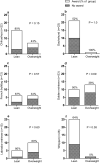Overweight in Swedish show dogs-prevalence and association with performance in competition
- PMID: 33902679
- PMCID: PMC8074276
- DOI: 10.1186/s13028-021-00582-2
Overweight in Swedish show dogs-prevalence and association with performance in competition
Abstract
Background: The prevalence of overweight and obesity is increasing in companion dogs, but little is known of these conditions in show dogs. This study assessed body condition score (BCS) of show dogs of six selected popular breeds at a major Swedish dog show event and examined the association between BCS and performance in competition.
Results: At one of Sweden's largest dog shows, BCS of 120 dogs of six different breeds was assessed by trained animal healthcare personnel, using a 9-point BCS scale with conditional cut-off for overweight set to BCS ≥ 6. Prevalence of overweight in the cohort was 32% but all overweight dogs except one displayed only slight overweight (BCS 6) and no dog was assessed as obese (BCS 8-9). Prevalence of overweight differed significantly between breeds (P < 0.0001) with Labrador retrievers, Golden retrievers and French bulldogs showing the highest mean BCS (5.6-5.7) and highest prevalence of overweight (50-67%). Lean and overweight dogs received awards and higher show awards (certificates) to the same extent, and no significant association between slight overweight and performance in competition was found.
Conclusions: Prevalence of overweight in Swedish show dogs was relatively high and in the same range as in the Swedish dog population as a whole. Dog owners, breeders and judges should be made aware of canine obesity problems and trained in BCS assessment, to better prevent canine overweight and associated health risks. This is particularly important for retriever and brachycephalic breeds, which showed high prevalence of slight overweight and have breed-specific health problems exacerbated by overweight. Owners and breeders of traditionally sturdy dog breeds should be informed that overweight dogs do not outperform lean dogs in competition.
Keywords: BCS; BCS assessment; Body condition score; Canine; Dog show competition; Obesity; Overweight prevalence; Show dogs.
Conflict of interest statement
Authors declare no competing interests.
Figures



References
-
- Bjørnvad CR, Gloor S, Johansen SS, Sandøe P, Lund TB. Neutering increases the risk of obesity in male dogs but not in bitches—a cross-sectional study of dog- and owner-related risk factors for obesity in danish companion dogs. Prev Vet Med. 2019;170:104730. doi: 10.1016/j.prevetmed.2019.104730. - DOI - PubMed
-
- Lund EM, Armstrong PJ, Kirk CA, Klausner JS. Prevalence and risk factors for obesity in adult dogs from private US veterinary practices. Int J Appl Res Vet M. 2006;4:177.
MeSH terms
LinkOut - more resources
Full Text Sources
Other Literature Sources
Medical

